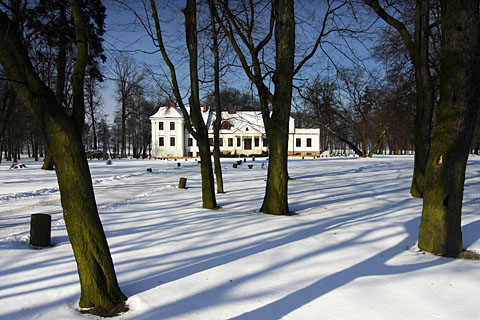 20
December
2025
20
December
2025
Manor house in Chotow

“I`m the Polish manor” - this sign could successfully be on the facade of the residence in Chotów, which presents typical features of nobel seat. We do not exactly know when our manor was established but its style and structure suggest that it was probably in the middle of XIXth century, extremely hard times for entire nation. During the annexation the major role played in polish society the nobility. In their hands sit obligation to cultivate the culture or cope with hard realities of lost independence. Owners of Chotów vitally were involved in patriotic activities. You should know, that nest to the manor’s park went a border line between the Prussian and Russian empires. History of the village itself, however, are much older than the nineteenth century, because he first mention about it appears in the 1403 .Over the years the village was ruled by such families as Wyganowscy, Węgierscy or Niemojowscy. In 1668 there already was an old manor belonging to Sophia and Hedwig Rossowscy. According the vision of the property conducted in 1721 we knew what it looked like the whole premise. "(...) Building leaning, half crawled the earth, but that does not fall, covering on him bad, just the same hole. Manor alias cottage on small hall and room breadth and length of six cubits, having. From this chamber the room with double doors, covered with a lining, stove and chimney in the building a simple, peasants labor. (...) ". As you can see from the description of the status of the estate left much to be desired, as it was finally dismantled. Continuator of the tradition of the manor is the current building, which counted over 150 years. Surrounded by a landscaped park from the second half of the eighteenth century, forming a harmonious whole with nature. Manor`s assumption is preceded by a stylized manor gate, and that "still open to passers announces that is hospitality and all are welcoming and inviting " - as indeed wrote Adam Mickiewicz in a memorable Pan Tadeusz. To the front of the residence lead an avenue of hornbeam ended with oval lawn, which creat so-called court d'honneur - courtyard of honor. Under him hurried splendid carriage.

As befits a landowners resident entry is preceded by a four-portico so-called . "small order", surmounted by a triangular pediment in the tympanum is a small window. Firstly it wasn`t a very large estate, but that changed during its development carried out during the 20`s of 20th century with the bunk in the west wing and housed annex with a kitchen in the east wing. The owners of the manor in those days was very well deserved for the region and our country Niemojowscy`s family from Śliwnik. Before those works, Waldemar Schilling, ostrowski photographer, has took the oldest know photos of the residence, moreover, issued in the form of postcards. It shows the avenue leading to the manor, which shines on end of the row of trees. Porch was covered with lush vegetation then. In 1935 Chotów passed into the hands os Cybulscy who hadn` known yet know that a few years later they will have experienced the true horror here. Idyll ended with the outbreak of World War II. First repression owners` family of manor suffered from the Germans. Witold Cybulski was arrested, but thanked to the numerous contacts of John Pętkowskiego from nearby residences in Śmiłowie manages to pull him out of jail. Next years brought further fighting landlords, and the entire culture associated with them, by the new authorities. By Decree PKWN on agricultural reform from 1944 removed force the former owners. Practically for all estates, this meant a slow degradation. This was the fate of the nearby mansions Śmiłowice, Sulisławice Żydów, palace in Śliwniki, Głóski and thousands of similar among the whole country. Cybulscy were expelled from their home and banned from coming back, and landed property in Chotów began to serve as living quarters for many families. Those days accomplished unimaginable destruction through deliberate devastation of the interior and the inexorable effects of time. Not repaired for years house not only scared with it looks, but slowly became a threat to people who lived there. The social and living conditions were at a very low level. This would seem a hopeless situation which changed when the investor bought the manor. That was the last bell for this place. During the general overhaul, which began in 2004, restored preserving the original plaster detail , door and window frames, roof adapted for residential purposes and basement for the restoration to the vaults beneath the oldest part of the building. No less work has been done in reclaimed the park of 6.3 hectares area, together with the entire water system. After the grange assumption nothing has left, not counting the picturesque ruins of vegetated barn. Today is shaped a new image of the manor, not as the seat of the landowners being the center of the farm, but a place adapted to modern needs.Restaurant Chotowa Old Manor opens its doors for the arrived gourmet of homemade food in a carefully restored climates of the past years . It is also a place to organize weddings, trainings and conferences ..


